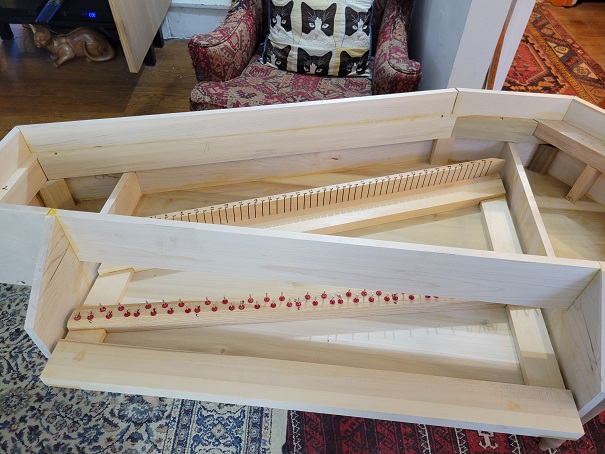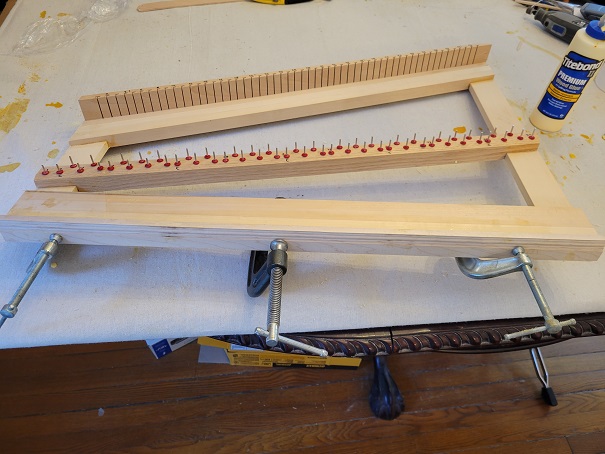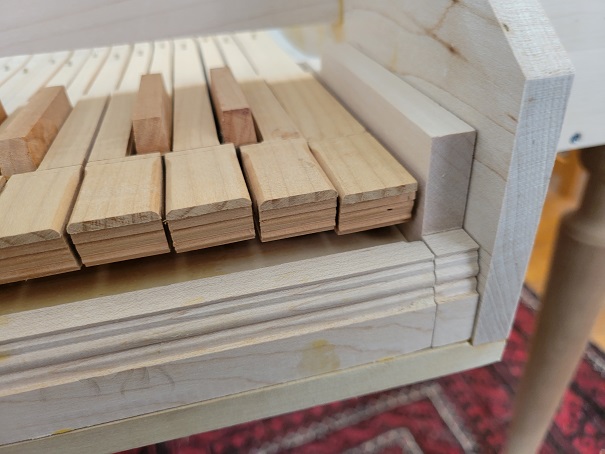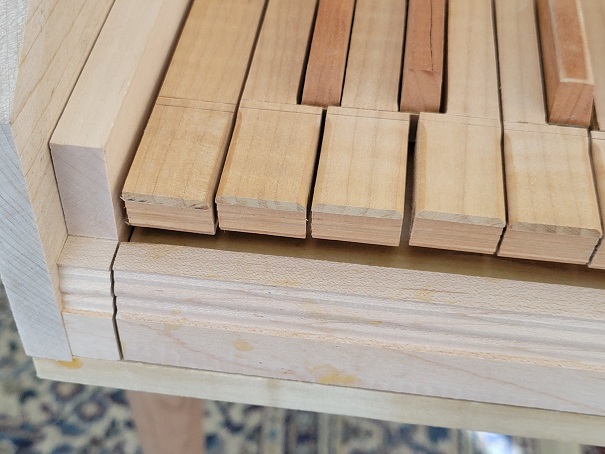Building a Virginal: The Transposition Feature
March 31, 2023
Roscoe
It is one of the most recognizable sounds in music: A lone oboe in the middle of an orchestra plays an A above middle C. The rest of the orchestra (except the strings) join in, tuning their instruments to that tone. Then the concertmaster (the first violinist) plays that same note, and the rest of the strings tune up. To the audience, this common and familiar ritual is both relaxing and exciting, for it signals that the conductor will soon enter the stage and the concert will begin.
Why does the oboe play an A? Western music has adopted C as the beginning of an octave, so why not a C?
Simple: String instruments must tune on open strings, and there is no C string on the violin. There is, however, an A string (the second highest string on the violin). This A is also the highest string on the viola, and the cello is tuned one octave below a viola, so it too has an A string, and the double bass is tuned one octave below a cello, so ditto.
Prior to this tuning ritual, the oboist has tuned her instrument to a reference standard, usually so that the oboe’s A has a frequency of 440 Hz, creating a soundwave that vibrates 440 cycles a second. This tuning standard is often simply called A 440.
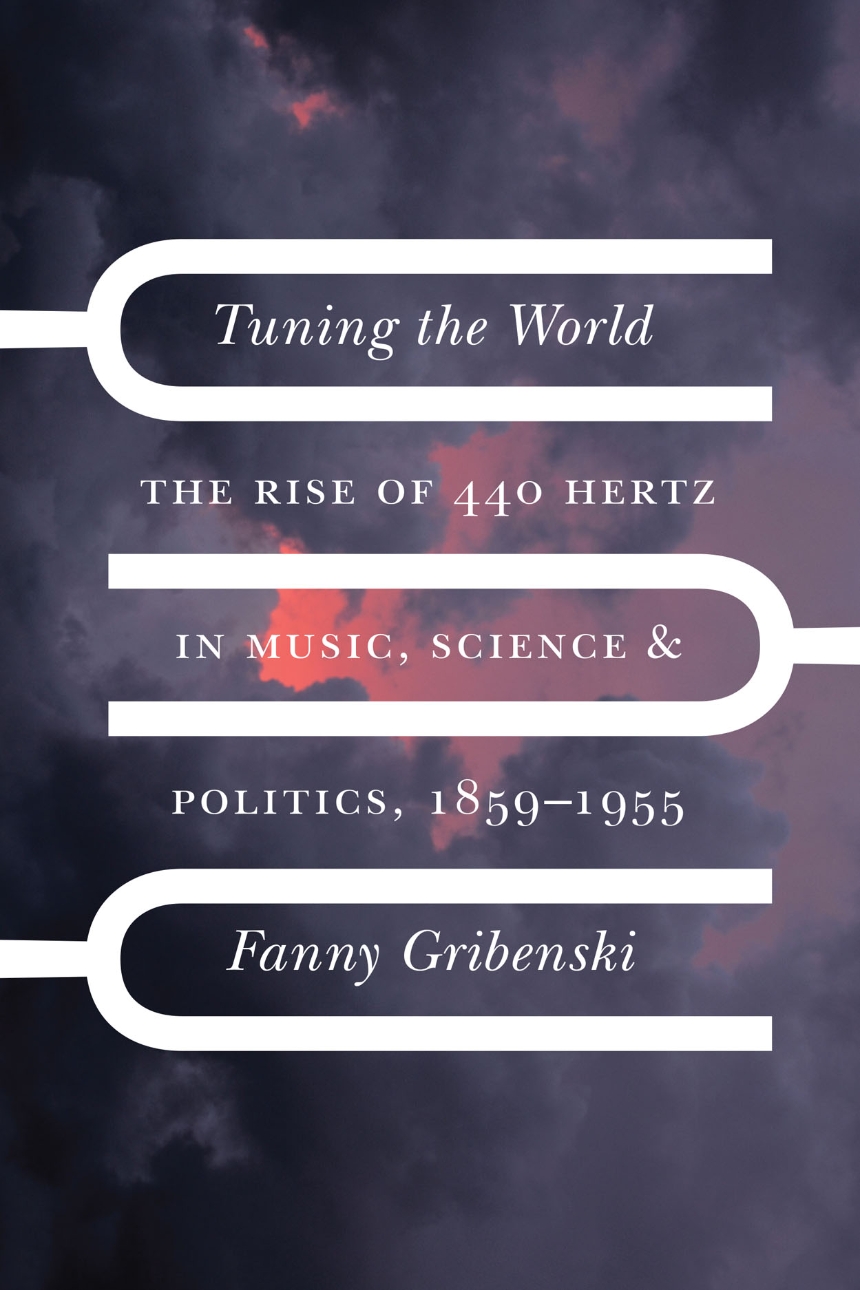
Why 440 Hertz?
That answer is the subject of a fascinating new book by New York University music professor Fanny Gribenski entitled Tuning the World: The Rise of 440 Hertz in Music, Science, & Politics, 1859–1955 (University of Chicago Press, 2023). It is a complex story that involves aesthetic, scientific, industrial, and political considerations, including globalization.
Gribenski’s history begins in 1859 because that’s the year that the French government declared a tuning standard called the diapason normal that was imposed on all state-funded and state-controlled music institutions. Over the years, the phenomenon of “tuning creep” had become more apparent. Orchestras would tend to tune sharper and sharper to give themselves a brighter, more distinctive, sound. This trend required vocalists to sing higher, threatening the integrity and longevity of their voices.
One of the instigators of a standard pitch had been Jules-Antoine Lissajous, whose famous patterns are known to oscilloscope users. In the spirit of the metric system, he proposed a standard of 1000 vibrations per second (or 500 Hz) for the B above middle C.
Those of a more mathematical inclination tended to favor setting middle C at 256 Hz because it’s a power of 2, so that the C in lower octaves are 128 Hz, 64, 32, and going down below the threshold of hearing. Violins can’t tune to a C standard, however. In equal temperament, the A corresponding to C 256 is 256 times the 9/12th root of 2, or 430.54 Hz, which might not look quite right on tuning forks. (This is still known as “scientific tuning".)
The French commission in charge of developing a standard pitch referred back to what they perceived to be a golden age of French grand opera in the 1830s, and “resolved that pitch should be kept at the level it had been during this glorious period of France’s musical history.” (p. 50). However, the exact figure of A 435 was arbitrary.
Partially because the French standard was based on French opera, it did not travel well outside the country. Since 1834, some German musicians had standardized on A 440, called “Stuttgart pitch” and based on an average of surveyed instruments.
Over the next century, many conferences and commissions attempted to set a standard universal pitch, and some surprising figures weighed in. In 1881, Verdi proposed a standard of A 432 for its “mathematical exigence” (p. 78). This is what you get if you assume that middle C is 256, and multiply by 27/16, which is the interval of a major sixth in Pythagorean tuning. But if A is set to 432, then in equal temperament, middle C is actually 256.87 Hz. Set one note to a round number, and other notes fall off the other end of the shelf.
Back in the early 1970s, I read the of a 1954 Dover reprint of the English translation of Herman von Helmholtz’s On the Sensations of Tone as a Physiological Basis for the Theory of Music, a groundbreaking book originally published in 1863. (This Dover reprint was a common sight on geek bookshelves during this era.) It was interesting to me to find the role that Helmholtz’s book played in the tuning debates. Although Helmholtz did not advocate a standard pitch, apparently whenever he needed one, he used the old Stuttgart pitch of A 440. This and the writings of Alexander J. Ellis (who translated Helmholtz into English and appended an essay “On the History of Musical Pitch") were influential in moving the standard to 440 Hz.
But this took a lot of time, and Fanny Gribenski provides many delightful excursions into the various pathways and justifications of different pitch standards. Quite surprisingly, an international commission promoted A 440 at the dawn of the Great War, briefly united countries soon to be at war. Radio also played a part in revealing a need for standards. It was thought to be too disconcerting for radio listeners if pieces of music using different tuning standards were played one after another. The A 440 standard was part of the Treaty of Versailles, and I was surprised to learn that it was even formalized by the International Organization for Standards. The only ISO standard for music is ISO 16, which became a recommendation in 1955, the year that Fanny Gribenski’s history ends.
This debate over tuning standards will never end, however. European orchestras in particular tend to tune a few Hertz above standard pitch for a brighter sound. A movement promoting the Verdi pitch of 432 Hz has also formed and have identified it with both quasi-spiritual concerns and fringe politics. An extensive discussion of this phenomenon can be found in an article in “Perfect Pitch: 432 Hz Music and the Promise of Frequency” (Journal of Popular Music Studies, Vol. 33, Issue 1, March 2021) and an article on the Vice website: “The 432Hz ‘God’ Note: Why Fringe Audiophiles Want to Topple Standard Tuning".
But I’m not interested in that. What I’m interested in is A 415.
In the 1960s and 1970s, a movement began to play Baroque music with more historic sensitivity. Historically informed performance (as it was called) attempted to play this music as it might have been heard back when it was composed. This involved the use of period instruments (or copies) and smaller ensembles. (For examples, check out the YouTube performances of the Bach Brandenburg Concerti by the Netherlands Bach Society.)
It is well known that pitch during the Baroque era varied all over the place, but in general, playing Baroque music at a slightly lower pitch than A 440 gives us a hint of how the music originally sounded. Fanny Gribenski writes “Nicholaus Harnoncourt was one of the most influential promoters of A 415 as an alternative to A 440 through his performances with the Concentus Musicus of Vienna.” (p. 190) The appeal of A 415 is that it is an approximate semitone below A 440. (In equal temperament, a semitone below 440 Hz is an irrational number closer to 415.30 Hz.)
I’d be interested in reading a history of how A 415 developed. I found a New York Times review of a Nicholaus Harnoncourt concert entitled “Bach in Ye Olde Instrument Shoppe” and reports that “Harnoncourt uses what is virtually a chamber ensemble of old instruments, playing about half a tone below modern pitch.” I wonder if he perceived that by ear. Fanny Gribenski notes that for someone with perfect pitch, Bach’s Mass in B Minor played in Baroque pitch might sound like a Mass in A♯ Minor (p. 15).
The book Early Music: A Very Short Introduction by Thomas Forrest Kelly (Oxford University Press, 2011) slips into passive voice when discussing the origins of A 415:
[A]fter many discussions in the early-music world it was agreed, for ease of playing together, that modern “Baroque pitch” would be exactly a semitone below modern pitch (this was chosen to be fairly close to at least some versions of eighteenth-century pitch, and to make it possible for harpsichords and organs to participate by transposing the music down a semitone). It then became necessary for builders to make instruments to this standard, and harpsichord makers began to make “transposing” instruments, in which the whole keyboard can be shifted sideways to play at either modern or Baroque pitch. (pp. 75–6)
One of those “harpsichord makers” is Zuckermann Harpsichords International, and I am personally interested in A 415 because I’m in the process of building a Zuckermann Troubadour Virginal. The Troubadour Virginal page of the Zuckermann website includes a Specifications section, with the first item being:
1x8’, 54 notes. C to f3, transposable to A 415 or 440
The first number indicates one set of strings (i.e., wires), also known as a choir. The 8’ designation stands for eight-foot pitch. The terminology comes from organs and doesn’t refer to any length in the harpsichord. It merely means that the strings sound at the normal expected pitch. Some harpsichords also have a 4’ choir, which sounds an octave higher, and a 16’ choir, which sounds an octave lower, and even sometimes a 2’ choir (two octaves higher) or a 16’ choir (two octaves lower). But the Troubadour Virginal has only one choir sounding at normal pitch.
The next part of this specification indicates that the virginal can play 54 notes — that’s not entirely true, but hold on a moment — with a range of C to f3. That’s a way of denoting notes and octaves that originated with Hermann von Helmholtz. It uses a mix of capital letters, small letters, and numbers. Three octaves below middle C is denoted as CC, an octave higher than that is C, and then an octave higher is lowercase c. Middle C is denoted as c1, an octave higher is c2, and two octaves above middle C is c3. The remainder of the octave following C is denoted similarly. The range “C to f3” means a range from two octaves below middle C, to the F that is above two octaves higher than middle C.
Then comes the phrase “transposable to A 415 or 440,” which means that you can switch between these two standards without retuning the whole instrument. You’ll see how this works shortly.
The next line in the specification reads:
Extra key in the bass, allowing you to tune any note you want below the low C; or you can tune the bass to a GG/BB short octave.
So there are actually 55 notes, and 55 keys on the keyboard, and 55 strings. The keyboard appears as if it starts with B, which using Helmholtz notation is BB. But you’re not stuck with that. Instead of the five lowest notes being BB, C, C♯, D, D♯, E, you can tune them to GG, C, AA, D, BB, E, or if that’s too confusing (because it’s out of order) GG, AA, BB, C, D, E. That’s called a short octave, and for some music, it’s likely to be more useful than the C♯ and D♯.
One of the pieces that I’ve been practicing, and which I’m looking forward to playing on the virginal, is Mozart’s Fantasia No. 3 in D minor. It’s almost always played on a piano but I’ve been playing it on my Yamaha Digital Piano with a harpsichord voice, and I’m liking it. The range of this piece is generally C to f3, so it’s perfectly suited to the Troubadour Virginal keyboard. However, at four points, Mozart calls for an AA, so what I’ll need to retune the lowest key on the virginal to AA. Simple!
The transposition feature of the Troubadour Virginal is accomplished by simply shifting the keyboard left or right.
Before I closed up the interior of the virginal by installing the soundboard, I did some work fitting the keyboard frame into the case:
Fitting required a little sanding. You might notice that the keyboard frame is narrower than the space in the case. That’s because this photo does not show the transposing block that also fits in there.
To get the keyboard fitted right, I had to glue on the keyboard front batten. The positioning of this is available only from the Mylar drawing of the virginal. It is glued to the front of the keyboard frame so that the bottom edge of the batten is flush with the bottom of the keyboard frame:
Then, when putting the keyboard frame into the case, the front of the batten is made flush (or nearly so) with the base of the case:
There will be case molding attached to the case that will extend along the bottom of the keyboard front batten.
Look close at that photo. To the right of the rightmost key (which is a little depressed because it hasn’t been properly balanced yet) you’ll see the transposing block. It has the same design as the keyboard front batten so it almost blends right in. It’s width is 1/12th of the octave.
To transpose the keyboard, the transposing block is removed, the keyboard is physically shifted sideways to the right, and the transposing block is inserted to the left of the keyboard:
To secure the keyboard in either of the two positions, I drilled two holes through the bottom of the case into the front rail of the keyboard frame, and then secured the frame with two screws, both in the transposed and non-transposed positions. (This is described on page 40 of the Construction Manual.)
Normally, the transposing block is on the right, and the 55 strings of the virginal are tuned based on A 415. The first key plucks the first string, the second key plucks the second string, dot dot dot, the 54th key plucks the 54th string, and the 55th key (the f3 key) plucks the 55th string.
To transpose the virginal to A 440, you remove the transposing block, shift the keyboard to the right, and insert the transposing block on the left. Now each key is plucking a string that is a semitone above the string in the non-transposed position. The first key plucks the second string, the second key plucks the third string, the 54th key plucks the 55th string, and the 55th key plucks the ... uh oh. There are no more strings left.
The implication is simple and disturbing: In the transposing position, the topmost key does nothing.
This has been bothering me for some time. I suspect I will be playing mostly Baroque music on the virginal, and I’d like to play this music at A 415. However, I do have a friend who plays flute and is interested in trying out some of the easier movements in the Bach Flute Sonatas, which means I’ll need to transpose to A 440. In that case, I hope I don’t need that f3 key.
Another option is simply to ignore A 415 by setting the keyboard to the non-transposing position, and tuning it to A 440. The problem is that the stringing schedule supplied with the wires specifies “A=415Hz". If I tune instead to A 440, I risk stretching the wires beyond their breaking point.
I was obsessing about this problem so much that I had one of those half-waking half-sleeping “dreams” where I imagined modifying the virginal so that it had 56 strings instead of 55 strings. In the non-transposed position, the 55 keys would play the lower 55 strings, and in the transposed position, the 55 keys would play the higher 55 strings. In my head, I performed this modification by adding another hitch pin on the left, and another tuning peg on the right, and extra bridge pins on the two bridges, and an extra slot to the box guide. But when I examined that box guide in real life, there was simply no room to add another slot.
At this point, I still don’t know how I’ll be tuning the virginal. I’ll probably go with A 415 at first.
But I don’t like how a penalty is exacted when the Troubadour Virginal is transposed. That’s a design flaw.
